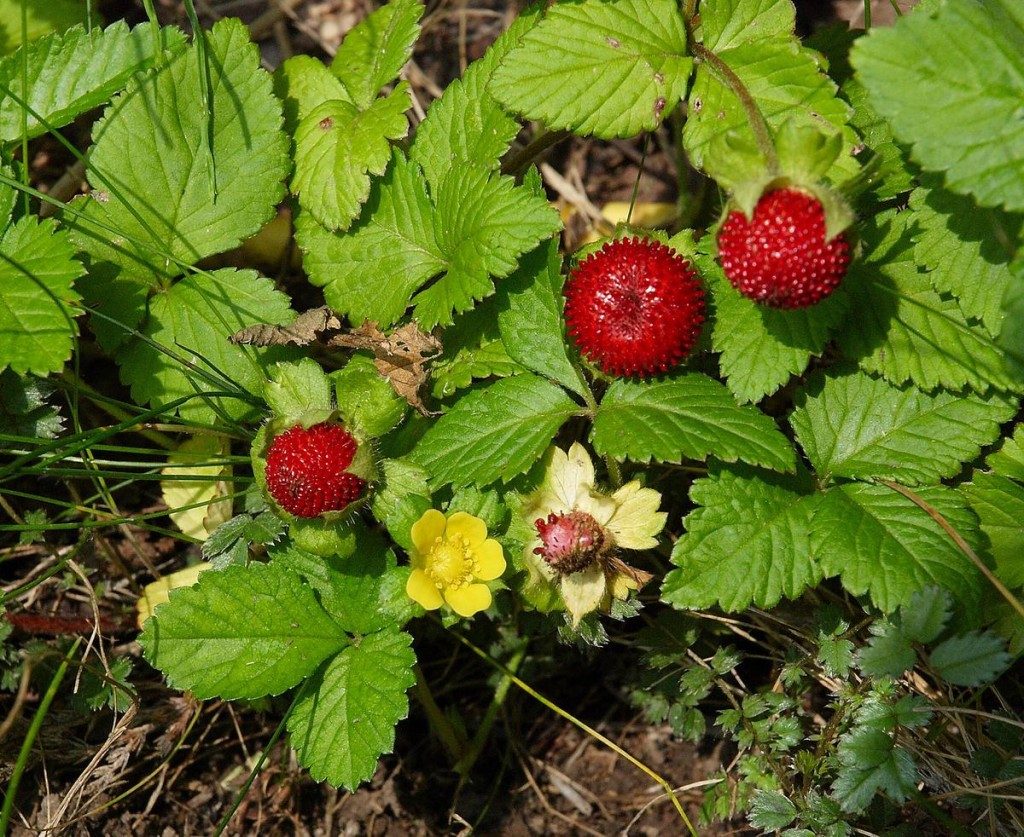Potentilla indica: Mistaken Identity
One of the first things my uncle’s second wife said to me when I moved from Maine to Florida was “they have strawberries here with no taste.” And she was right, almost.
The Potentilla indica, (poh-ten-TIL-ah inn-DEE-kuh) the India Strawberry, indeed has little flavor but it’s not a Southern speciality. It grows in Canada. In fact, it is found in most places except the Rocky Mountain states* and upper New England. Flavorless or not my cousins and I ate a lot of them.
On first glance the P. indica looks like you have found yourself a brilliantly red, juicy strawberry. And that is probably the public relations problem P. indica has. It’s not what people expect so a lot of commentators dismiss it as worthless, but that’s a bit unfair. The fruit is 3.4% sugar, 1.5% protein and 1.6% ash. It has 6.3 mg of Vitamin C per 100 ml of juice. An eight-foot patch will produce about 5.5 ounces fruit annually, about the same as wild strawberries, and you can cook the leaves as a green, or use them for tea. Some folks think the fruit has a hint of watermelon flavor. Others say it is sour so there may be some genetic diversity there, either in the plant or our taste buds. There is certainly no harm adding some of the plant to your wilderness stew.
Be forewarned though, there is descent into negative exaggeration. Many sites state the fruit is edible but tasteless. Others translate “edible but tasteless” into “not suitable for human consumption.” Some translate “not suitable for human consumption” into not edible. Others translate “not edible” into poisonous. Ph.d, herbalist and researcher James Duke, PhD., addressed the issue specifically in his “Handbook of Medical Weeds.” He says the plant is “often described as ‘poisonous.’ I have eaten hundreds and find the word insipid more accurate.” As far back as 1914 author Harrison Garman, writing about weeds of Kentucky, said the fruit was edible and “their appearance leading one to expect them to be more palatable.”
I have eaten many and seem to still be here. Some 31 years after I had swallowed my first Potentilla indica (then called Duchesnea indica) I read in John Wizeman’s SAS Survival Handbook the berries are “highly poisonous, sometimes fatally.” I think there is an error somewhere or two differnet varieties for there is an Indian herbalist who calls the P. indica mildly poisonous and a treatment for cancer. In my experience the leaves, besides a potherb, dried make a nice tea. The berries can help stretch other berries when making jam and jelly. On their own they make a mild jelly or juice for those hot summer days.
There are …. blooms… of inaccuracy on the internet. As mentioned one is that the Indian Strawberry is toxic. The FDA Poisonous Plant database puts that rumor to rest. It is not toxic. Another is that it affects blood. There apparently is no research on that. Some herbal traditions say it increases blood flow and others that it decreases blood flow. There is, however, modern research that suggests the species can stimulate the immune system (in mice at least.)
Potentilla means strong, powerful, and the plant and many of its relatives in a family considered to have good medical value. Indica means from India though the plant is native to southern Asia (though some also think it is native to North America… does it really many any difference?)
* In the fall of 2011 I received an email from “Becky” in Boulder, Colorado, definitely a Rocky Mountain state, and she said she uses Indian Stawberry as a ground cover. It not only thrives, she says, but is good at driving out other plants. Ground cover, food and gets rid of non-edible weeds. Not bad.
Green Deane’s “Itemized” Plant Profile
IDENTIFICATION: Low, trailing vine, roots at the nodes. Single flower on long stem, five yellow petals are notched at tip, five sepals. Long-stemmed leaves have three blunt-toothed leaflets, strawberry-like fruit, seeds on outside.
TIME OF YEAR: Fruits in September in temperate climes, sooner in warm areas.
ENVIRONMENT: Prefers moist, well-draind soil, sunny location with passing shade, can be invasive, spreading freely by runners, more or less evergreen in southern ranges.
METHOD OF PREPARATION: Berries raw, leaves raw in salads, leaves cooked as a green, leaves dried for tea.


